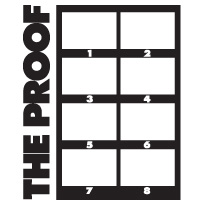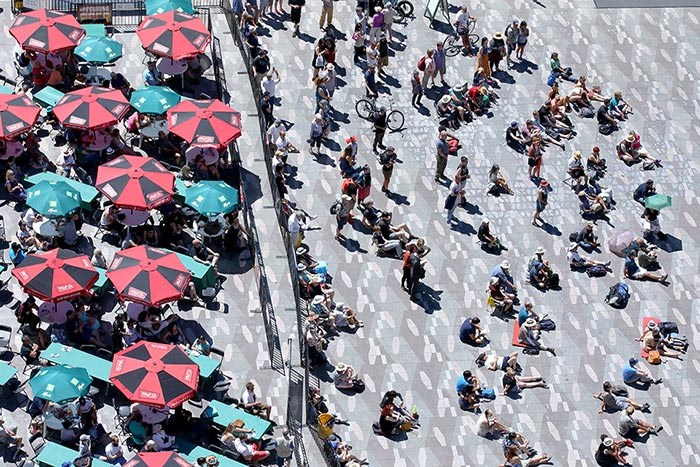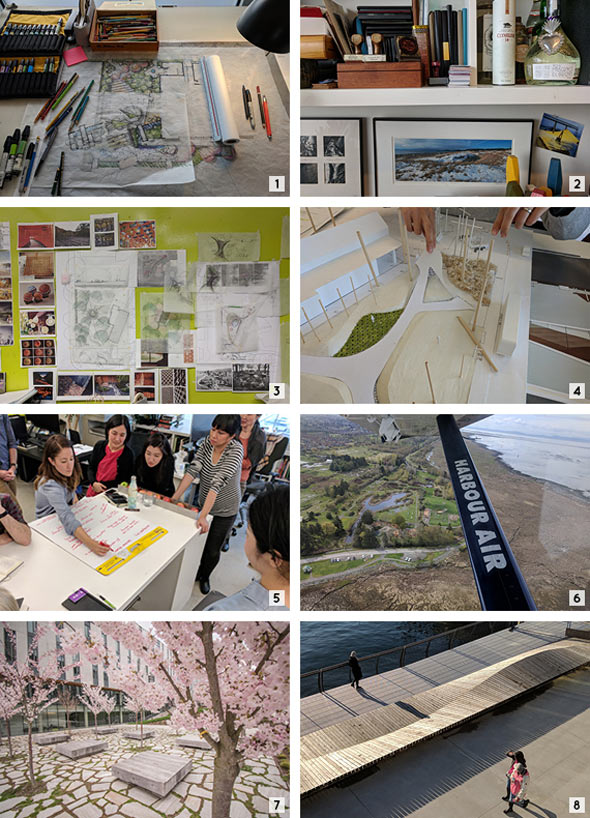 |
THE PROOF is a weekly roundup showcasing local creatives. A column for creatives to share their story and work, in a unique, concise format: each creative shows 8 pictures and answers 8 questions. Past participants include Bob Kronbauer, Omer Arbel, Hannah Georgas, Carson Ting, Lizzy Karp, Andy Dixon, Graeme Berglund, Karen Duncan of VOKRA – all living in Vancouver. |
 VAG North Plaza Redevelopment. Photo: Hapa Collaborative
VAG North Plaza Redevelopment. Photo: Hapa Collaborative
Joe wears many hats - none more passionately than that of landscape architect. Joe is the principal and owner of Hapa Collaborative. With an intense love of design and of both public and private spaces, Joe works thoughtfully and purposefully to uncover the untapped potential of each space that he and his team have undertaken. He takes great care to learn the history of the spaces that he and his team design and is careful to pay respects to the story and the neighbourhood behind each project. Fierce in his goal to create memorable and usable public spaces, Joe works hard to stretch conventional boundaries and assumptions.
Joe believes in true collaboration – both within his team at Hapa and with his clients and their professional consultants. Hapa’s latest projects demonstrate the success that comes from their collaborative efforts. When not behind a desk, in a meeting or out and about sharing his thoughts on urban design, Joe is a dedicated father to two active children, both of whom share another passion of his – hockey. Known for his approachable nature, passion for his work and his dedication to the pursuit of creating memorable spaces, it is no wonder that Hapa has quickly become one of the most sought-after landscape architecture firms in the city.

THE PROOF
- My drafting table with our latest ideas for a new Chinese Canadian memorial garden in New Westminster.
- The shelf above my desk, a few of my favourite things.
- We try to do regular pin-ups and crit sessions along with beer, this is for one of our projects in Steveston.
- Matt Corker of Corker and Co has been leading us with some visioning work in the studio, and helping our managers online and one-on-one. This is us brainstorming our goals for the year.
- Hanako, Pengfei and I reviewing our site model for Steveston Nikkei memorial.
- Flight over Terra Nova Play Environment, looking good in early spring, on our way to a workshop at the University of Victoria.
- Our hanami benches at Ponderosa Commons with the Akebono grove in bloom, March 2018. Hanami means ‘cherry-blossom viewing’ in Japanese.
- The Megabench on the North Vancouver waterfront, the best seat in the house. We will be leading a Vancouver Design Week review of the Megabench on May the 12th, 12:30pm!
THE QUESTIONS
1. Can you tell us a little bit about yourself?
I was born in Northern Ontario, small town on Lake Superior. Growing up was fun, but the landscape around – painted by Group of Seven, Charles Comfort - is what I miss the most, truly sacred, and still undiscovered country. My mom’s family moved there after WWII, from Powell Street in Vancouver to internment in Slocan City to finding work in Ontario, and my parents met there. After school, I ended up in Vancouver in part for work, but contextually I think there was always a call out to the coast. Vancouver and Steveston, where my wife is from and where we live, is really the best place to start a landscape architecture practice, it’s not who you know (like Toronto or Montreal) but what you have to offer. Hapa Collaborative would likely not be as successful if we tried this in another city first.
2. How did you come to be a Landscape Architect?
My dad was a forester, always lots of maps, drawings, aerial photos, pens and pencils around, but also a hobby gardener and I liked to help him dig, plant and build things. I think the landscapes of my childhood – the Great Lakes, the boreal forest, the Canadian Shield – still loom large. I considered architecture or planning and then I remember seeing brochures for landscape architecture, and immediately was drawn to the idea, in fact it was really clear. I ended up applying and going to Guelph, the smallest of the bunch and really loved the program, my classmates, my profs. I immediately left for BC after graduating and worked in several offices in Vancouver and Seattle, including Bob Murase, a Japanese American landscape architect who I really revered in school. My toughest boss, my toughest critic. I matured a lot there, became a bit more accountable, serious and technically capable. I worked for a few other firms before starting Hapa Collaborative in 2009 learning a lot from all my mentors, but Bob in particular.
3. Where do you find inspiration?
Inspiration can come from just about anywhere, from taking a walk around the neighbourhoods where I live or work, or travelling to other cities particularly the cities of Asia, going to local galleries and sampling who’s doing really good design work, reading or watching biographies about people in allied fields of design. I love reading Seth Godin and his blog, his books, to give me a real kick in the ass that I need sometimes. I sense that I have been good at copying the habits or ideas of the people I admire out there, and have started to be confident enough to make the ideas more personal or relevant to the site or the place, but it starts with this external spark that can come from the most unlikely places sometimes. I also think we do a good job on researching the places that we work on/in, finding a spark in the past uses of the place. Although nature and natural systems are important to our work, I find it more interesting to respond to the historic and cultural relevance of the place, and revive some of that in a contemporary manner.
4.Can you describe your creative process?
It’s really non-linear and random, with very little structure or rationale to it, but it is iterative and responsive. I find drawing and modelling away from the computer is a skill that I’ve developed and honed over many years, and it is really the foundation of creativity for me, exploring ideas on paper or in clay or styrofoam, sketching and sculpting, turning it upside down, looking at it from another angle. Alvar Aalto described drawing as – not the process of the brain telling the hand what to do, but the exact opposite – the hand informing the brain what is possible. When I heard that quote it all made sense to me! There is a lot of ‘call and response’, and it requires time and space to do really well. I find that there is a unique collaborative creativity when we pin-up, present and defend our work internally before we print and send. It’s great to see the hands of many people influencing the design and the visuals that we prepare, rather than just my personal design biases.
5. What are you working on right now? Where can we find your work?
We are working on a few really interesting public realm projects that range in size and complexity, but have big impact into the way people engage in the urban realm and come to understand the cultural significance of these places. We are developing siting and landscape options for a new feasthouse, concession and washroom building at Cates Park or Whey-Ah-Wichen, in North Vancouver, a site of immense importance to the Tsleil-Waututh Nation, and we are learning so much about indigenous history, customs, materials from our client. We are completing a commemorative park and garden that acknowledges the Chinese Canadian community in New Westminster, and becomes a symbol of the reconciliation of the treatment of Chinese on the west coast. We are also developing continuing our work on the North Shore and looking at improvements around Lonsdale Quay and the market building. The most notable places to find our work include the North Plaza of the Vancouver Art Gallery with Nick Milkovich Architects, the Megabench in North Vancouver, Sun Hop Park and the orange red trellis at Main and 18th, the landscape spaces around Ponderosa Commons at the University of British Columbia, and a new park and playground at Rochester Park in Coquitlam.
6. What is your dream project?
A dream project is where we are in the middle of a design team, not leading per se but a key contributor, on a site with a lot of cultural historic layers and environmental issues, and dramatic, transformative change. We are working on several sites in North Vancouver’s Central Waterfront and they touch on all of these characteristics, challenging but really fun projects, good results, a fantastic client who understands what we are trying to do. I feel a great sense of obligation when we are working on sites designed by others, Robson Square by Arthur Erickson and Cornelia Oberlander, the University of Victoria by Don Vaughn and Lawrence Halprin are places where we need to walk in the shoes of our mentors, and its really a profound experience. Another dream project would be doing a series of landscape interventions, rest-stops or roadside attractions along the highways of BC or Canada like these ones in Norway. They could capture a beautiful view, tell a story of the site, they could be really kitschy and ugly but beloved monuments, and together they really contribute to the experience of landscape, travel and touring.
7. If you had a chance to start your career all over again, how would you do it differently?
I left school and started working right away, so travelling was not something that I got to do a lot of, and would have benefitted my understanding of the world more! So we’re making up for that now, taking time to travel with my family, and it’s been relaxing but also really illuminating and inspiring. However, getting right into the working world has allowed me to travel too, so there’s not much else I would want to change.
8. What advice do you wish someone would have given you when you were young?
I love this little video by Ira Glass of This American Life on storytelling, which pretty much sums up what I feel is most important when we are starting out. Do lots of work, test things out, revive your old ideas, do design competitions with other people you like working with, volunteer your time to causes that you care about. Do this while you still have time to spare before you have family obligations or need to run/manage a business. I am surprised and sometimes frustrated by the immediacy that our younger practitioners expect of their jobs, their careers without an understanding or appreciation of the process. Pay your dues, do your work, use the time wisely, and before you know it, you’re at the next level. PS, there is always a next level.
Joseph Fry and 10 other speakers will be presenting at the next PechaKucha Night Vol.45 at the Vogue Theatre on Tuesday, May 8th as part of the Vancouver Design Week.



